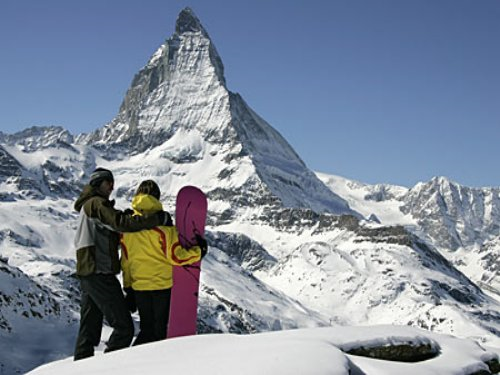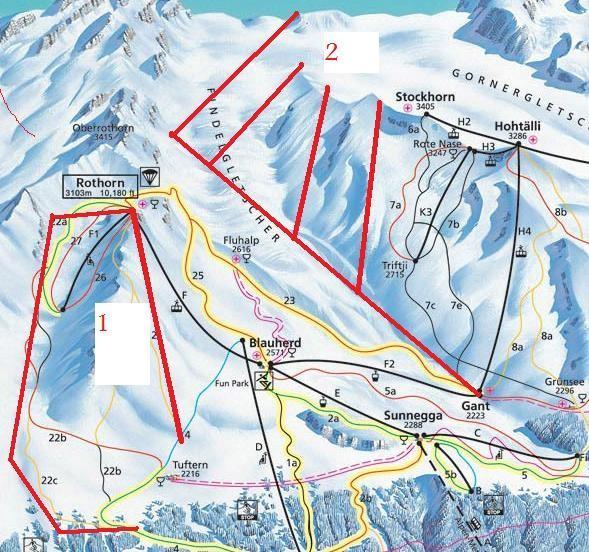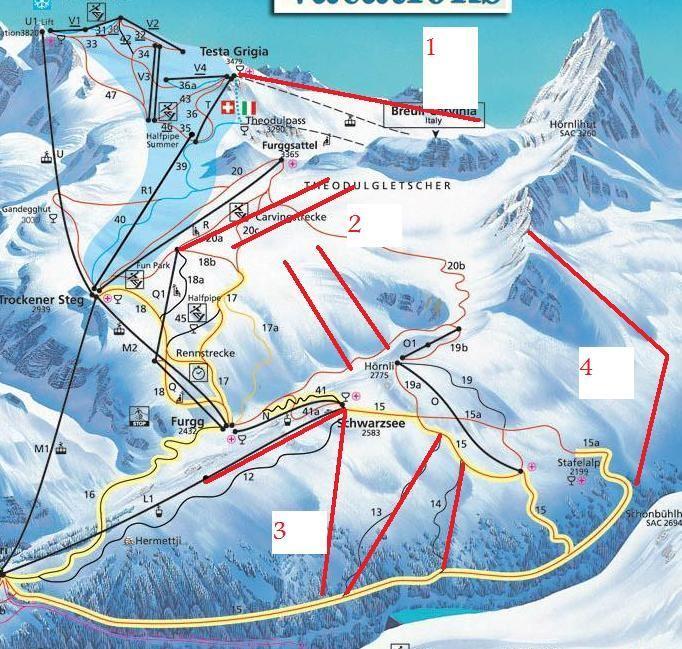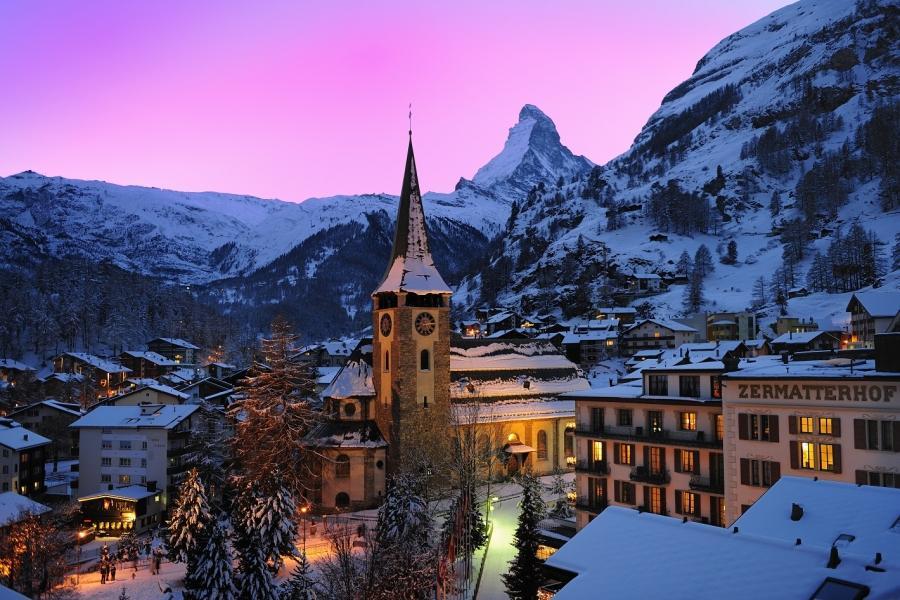Focus on Zermatt
This is the first in a series of mini-guides to the best off-piste / backcountry resorts in the Alps. The emphasis is on lift-served access rather than pure touring, however I will make reference to famous descents which require approaches on skins or foot.
These mini-guides are by no means comprehensive. They are drawn from my personal experiences of skiing in the areas mentioned.
Dominated by Switzerland's most famous landmark - the Matterhorn - Zermatt is certainly the country's best known ski resort. Many skiers - myself included - have no hesitation in naming Zermatt amongst the top 5 Ski Resorts in the world.

All three of Zermatt's ski areas soar to at least 3100m. This translates into excellent snow conditions, and long descents. Not only are the slopes long, but they are open for a long day. Lifts begin operation at 8-8.20am and do not close until 4.30pm in midwinter, while in April it is possible to still be skiing at 6pm. Zermatt also has the longest winter season in the Alps. All three ski areas are open from late November to the start of May - and the huge glacier area offers summer skiing.
The longest ‘lift served vertical descent is from the Klein Matterhorn into town a total of thirteen kilometres and 2200 vertical metres.
Zermatt has extensive off-piste terrain. Large and seldom skied fields of untouched snow await those 'in the know'. And thanks to Zermatt's extremely high altitudes and abundance of north facing slopes, powder snow can still be found many days after it falls... In spring especially, huge areas of both powder and spring (corn) snow can be found. Most of the terrain faces north and most slopes receive no sun midwinter, perfect for powder.
What is exceptional about Zermatt is the sheer volume of terrain available for both piste and off-piste skiers. The lift system consists of mainly modern, high volume cable cars, and what’s more Swiss efficiency means queues are rare.
ROTHORN, STOCKHORN

These areas are predominantly north facing and situated on the left side of the valley.
Area 1 (see map): The west (or front) face of the Rothorn gives a 1000m of off-piste at around 35 degrees. It feels great to leave the tourists at the Rothorn top station (3100m) and 30 seconds later to be on a huge remote mountain face with seemingly endless untracked snow. The snow on this face varies considerably because it catches the afternoon sun. Expect powder, hard pack or crust. Possibly all three. If conditions are good, there is enough scope to ski this face all day!
A gentle introduction to off-piste can be found from the Rothorn by heading east down the piste, then cutting left down the long Tufterchumme Valley, around 20/25 degrees.
Area 2: The Stockhorn and Gant areas are exceptional under good snow. North facing with vast potential.
The area under the Gant cable car is well known, but often ‘tracked out. It’s better to take the drag lifts to the Stockhorn itself and then walk (or skin) east along the ridge for 20 mins. Then head left down wonderful big rolling terrain for 1000m of descent (around 30/35 degrees). Fantastic powder is found here. Not to be missed.
For the ski tourer, from the Stockhorn skin for 2 hours to the summit of Cima di Jazzi (3800). Then take the long and spectacular Findelgletscher all the way back to Gant. 1600m descent, 20/25 degrees. A long and beautiful trip, although not recommended in deep powder or thin snow.
The Gornergrat area (adjacent to the train) offers lots of ‘intro’ terrain. This area tends to get crowded with mainstream skiers, so the connoisseur can find better sport elsewhere.
TROCKNER STEG, KLEIN MATTERHORN, SCHWARTZEE

These famous areas offer a great deal to the backcountry enthusiast.
AREA 1: Heading down to Cervinia, the upmost circle of slopes (accessed from the top plateau, which is the Swiss/Italian border) offer numerous good descents of around 600m with varying steepness. The mid-alt and lower Cervinia slopes are best avoided (flat and crowded!).
AREA 2: The Trockner Steg area offers good intro-off-piste terrain, the gentle area under the main chair (skiers left) is excellent for practicing powder turns.
Various routes down Trockner Steg to Furgg are worthwhile. Traverse hard left for a good distance from Trockner Steg, then over the rocky lip. The slope here is around 400m 30-40 degrees and north facing.
AREA 3: The Schwarzee offers good terrain from beginner to expert.
The area under the second gondola stage offers good intro terrain. But the best backcountry is to be found north of the top station. Head down the piste for around 1km, then cut off the piste and take the steep wooded hill side. This area in known as ‘Schwartzee trees’ and will attract local powder hounds when the conditions are good. Some routes are steep, 35-45 degrees.
AREA 4: A beautiful and remote trip, where you can almost touch the Matterhorn. Great powder, long, north facing and devoid of people. Pure white gold! It just takes a little effort to get to the departure point. From the Hornli drag, walk or skin up onto the ridge below the Hornli hut on the Matterhorn, 1 hour, care needed. Then take the wonderful north slope all the way down to Stafel 25-35 degrees.
FURTHER AFIELD: MONTE ROSA, SCHWARZTOR AND TETE DU VALPOLINE

The Monte Rosa area is one of the most heavily glaciated areas of Europe, and offers unlimited potential for the adventurous skier. Three itineraries are mentioned here.
AREA 1: The Dufour Spitz is accessed by helicopter, or an extremely long skin and a night in the Monte Rosa Hut. Skiers can either depart from the ‘landing platz’ at ¾ height or the saddle 100m below the summit. One of the longest vertical descents in Europe; 3000m to Zermatt, <35 degrees.
AREA 2: The Schwarztor is Zermatt’s answer to the Valley Blanche. Under good snow, this is one of the best descents in Europe. Begin from the Klein Matterhorn and make a long traverse to the col between Castor and Pollux. This is best done as a ski tour (1hour from KM) or as a heli-drop. Then descend the crashing glacier all the way down to the Gornergletscher. North facing with stunning scenery. Then follow the Gornergletscher eventually reaching Furi.
TETE DE VALPELLINE: Helidrop to the Tete du Valpelline (3800m) or Col du Valpelline (or a long skin). Then return to Zermatt via the Stockjigletscher and Zmuttgletscher. This descent is used on the last day of the Haute Route. Incredible glaciated scenery, the highlight being the traverse below the Matterhorn’s north face. One of the best and longest descents in the Alps. 2400 m vertical, <30 degrees and approximately 15km.
SUMMARY
Zermatt is one of the premier destinations for the adventurous skier. This article gives an introduction to the potential of the area. Locals claim it would take a lifetime to discover all the secrets of these mountains.
Plenty of great off-piste can be found near the lift systems, however many of the bigger more remote descents are ‘serious’, due to the altitude and glaciated terrain.
Please note, that making decisions regarding the level of danger on any off-piste route requires considerable expertise. Using a UIAGM guide to explore the backcountry of Zermatt is strongly recommended.
Mountain Tracks run courses in Zermatt. Please contact us for details.
 Off-Piste
Off-Piste Ski Touring
Ski Touring Via Ferrata
Via Ferrata Ice Climbing
Ice Climbing Alpine Glacier Trekking
Alpine Glacier Trekking Worldwide Trekking
Worldwide Trekking








 Travel Website Development
Travel Website Development